Corporate Financial Management: Causes, Impact and Recommendations
VerifiedAdded on 2023/04/23
|13
|2937
|485
AI Summary
This paper assesses the possible causes that erupted the global financial crisis and swept the industrialized banks across the world under bankruptcies. The paper would assess the impact of financial crisis in economies around the world and would also propose reformations to further avoid the occurrence of catastrophic financial disaster.
Contribute Materials
Your contribution can guide someone’s learning journey. Share your
documents today.
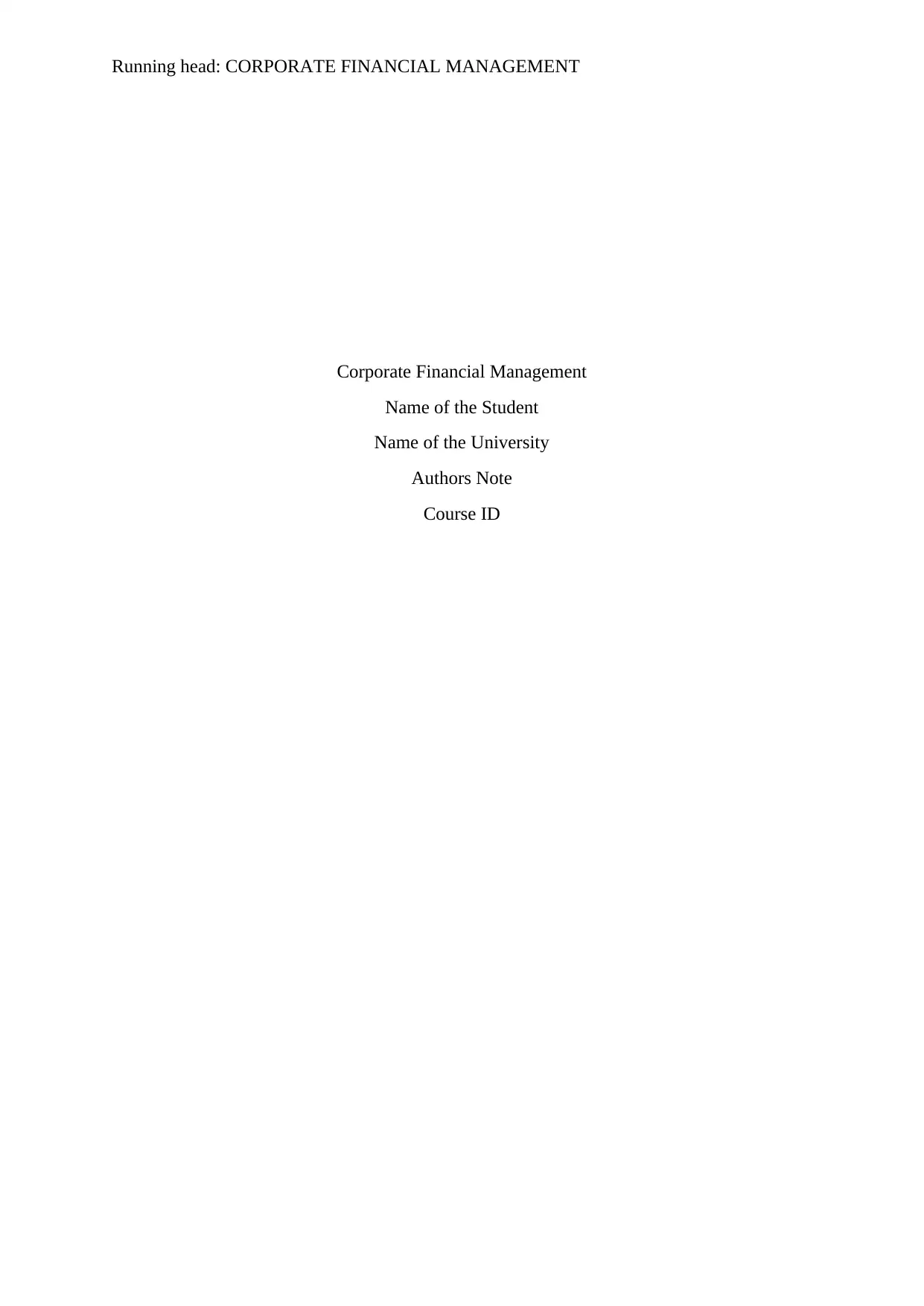
Running head: CORPORATE FINANCIAL MANAGEMENT
Corporate Financial Management
Name of the Student
Name of the University
Authors Note
Course ID
Corporate Financial Management
Name of the Student
Name of the University
Authors Note
Course ID
Secure Best Marks with AI Grader
Need help grading? Try our AI Grader for instant feedback on your assignments.
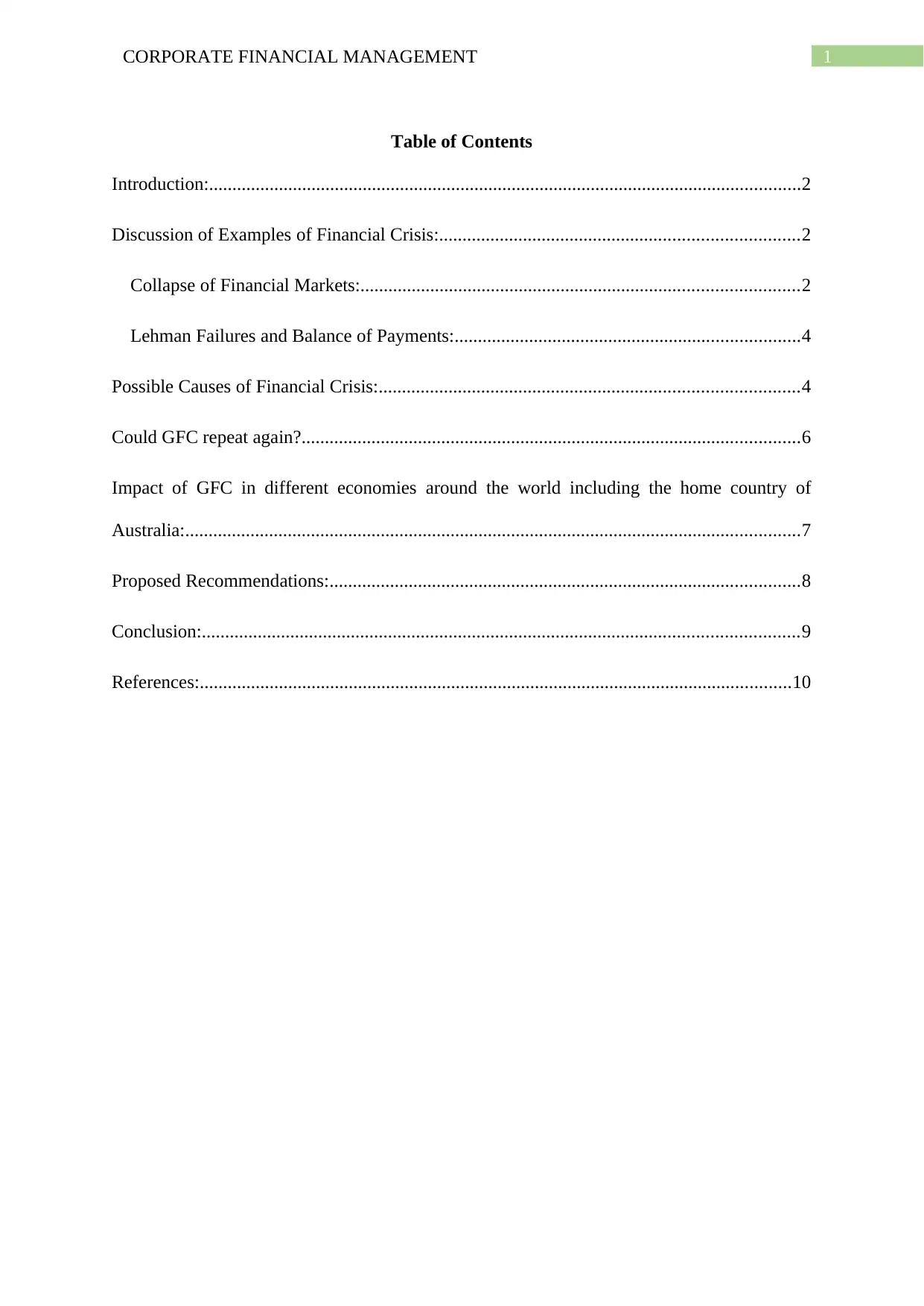
1CORPORATE FINANCIAL MANAGEMENT
Table of Contents
Introduction:...............................................................................................................................2
Discussion of Examples of Financial Crisis:.............................................................................2
Collapse of Financial Markets:..............................................................................................2
Lehman Failures and Balance of Payments:..........................................................................4
Possible Causes of Financial Crisis:..........................................................................................4
Could GFC repeat again?...........................................................................................................6
Impact of GFC in different economies around the world including the home country of
Australia:....................................................................................................................................7
Proposed Recommendations:.....................................................................................................8
Conclusion:................................................................................................................................9
References:...............................................................................................................................10
Table of Contents
Introduction:...............................................................................................................................2
Discussion of Examples of Financial Crisis:.............................................................................2
Collapse of Financial Markets:..............................................................................................2
Lehman Failures and Balance of Payments:..........................................................................4
Possible Causes of Financial Crisis:..........................................................................................4
Could GFC repeat again?...........................................................................................................6
Impact of GFC in different economies around the world including the home country of
Australia:....................................................................................................................................7
Proposed Recommendations:.....................................................................................................8
Conclusion:................................................................................................................................9
References:...............................................................................................................................10
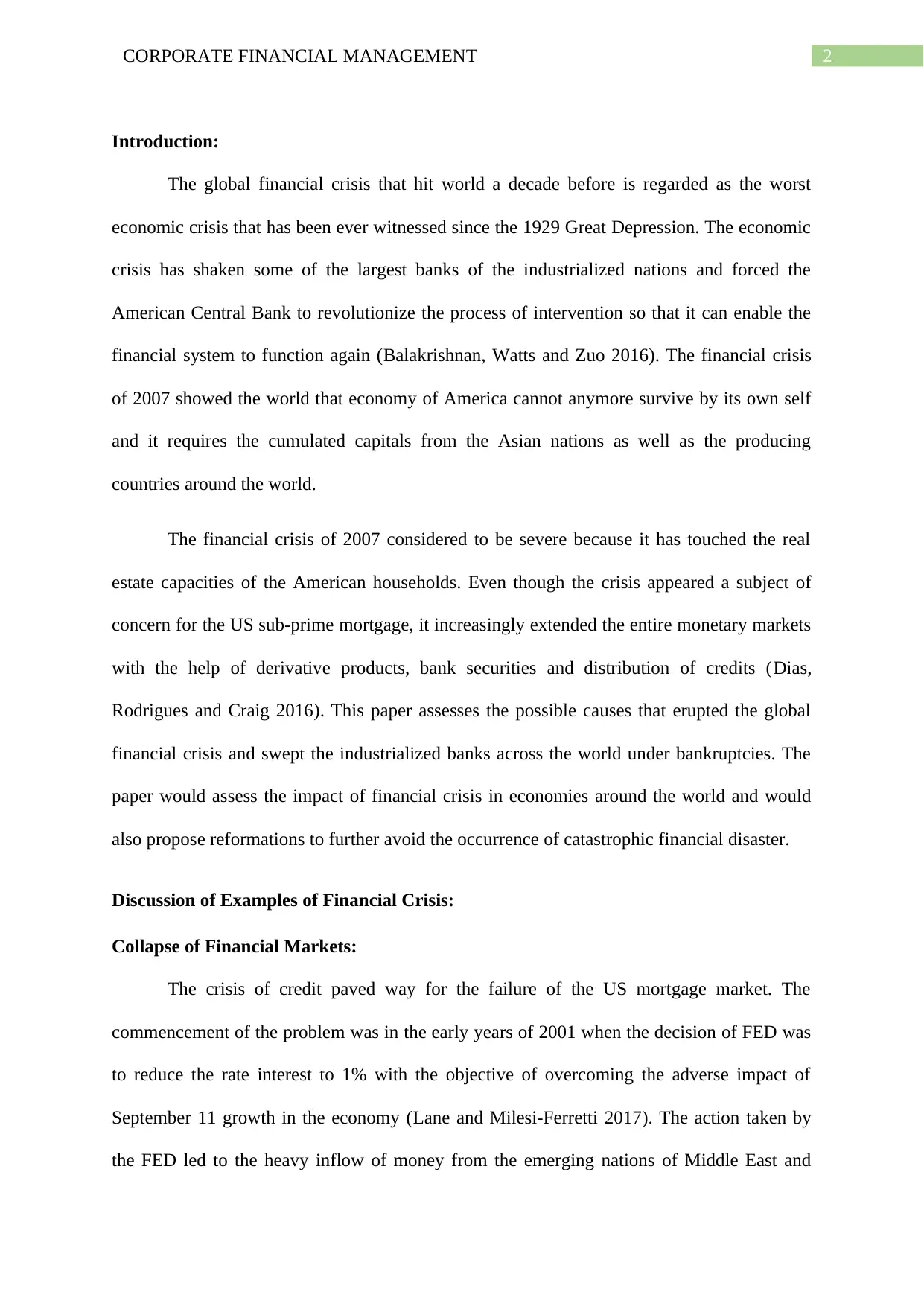
2CORPORATE FINANCIAL MANAGEMENT
Introduction:
The global financial crisis that hit world a decade before is regarded as the worst
economic crisis that has been ever witnessed since the 1929 Great Depression. The economic
crisis has shaken some of the largest banks of the industrialized nations and forced the
American Central Bank to revolutionize the process of intervention so that it can enable the
financial system to function again (Balakrishnan, Watts and Zuo 2016). The financial crisis
of 2007 showed the world that economy of America cannot anymore survive by its own self
and it requires the cumulated capitals from the Asian nations as well as the producing
countries around the world.
The financial crisis of 2007 considered to be severe because it has touched the real
estate capacities of the American households. Even though the crisis appeared a subject of
concern for the US sub-prime mortgage, it increasingly extended the entire monetary markets
with the help of derivative products, bank securities and distribution of credits (Dias,
Rodrigues and Craig 2016). This paper assesses the possible causes that erupted the global
financial crisis and swept the industrialized banks across the world under bankruptcies. The
paper would assess the impact of financial crisis in economies around the world and would
also propose reformations to further avoid the occurrence of catastrophic financial disaster.
Discussion of Examples of Financial Crisis:
Collapse of Financial Markets:
The crisis of credit paved way for the failure of the US mortgage market. The
commencement of the problem was in the early years of 2001 when the decision of FED was
to reduce the rate interest to 1% with the objective of overcoming the adverse impact of
September 11 growth in the economy (Lane and Milesi-Ferretti 2017). The action taken by
the FED led to the heavy inflow of money from the emerging nations of Middle East and
Introduction:
The global financial crisis that hit world a decade before is regarded as the worst
economic crisis that has been ever witnessed since the 1929 Great Depression. The economic
crisis has shaken some of the largest banks of the industrialized nations and forced the
American Central Bank to revolutionize the process of intervention so that it can enable the
financial system to function again (Balakrishnan, Watts and Zuo 2016). The financial crisis
of 2007 showed the world that economy of America cannot anymore survive by its own self
and it requires the cumulated capitals from the Asian nations as well as the producing
countries around the world.
The financial crisis of 2007 considered to be severe because it has touched the real
estate capacities of the American households. Even though the crisis appeared a subject of
concern for the US sub-prime mortgage, it increasingly extended the entire monetary markets
with the help of derivative products, bank securities and distribution of credits (Dias,
Rodrigues and Craig 2016). This paper assesses the possible causes that erupted the global
financial crisis and swept the industrialized banks across the world under bankruptcies. The
paper would assess the impact of financial crisis in economies around the world and would
also propose reformations to further avoid the occurrence of catastrophic financial disaster.
Discussion of Examples of Financial Crisis:
Collapse of Financial Markets:
The crisis of credit paved way for the failure of the US mortgage market. The
commencement of the problem was in the early years of 2001 when the decision of FED was
to reduce the rate interest to 1% with the objective of overcoming the adverse impact of
September 11 growth in the economy (Lane and Milesi-Ferretti 2017). The action taken by
the FED led to the heavy inflow of money from the emerging nations of Middle East and
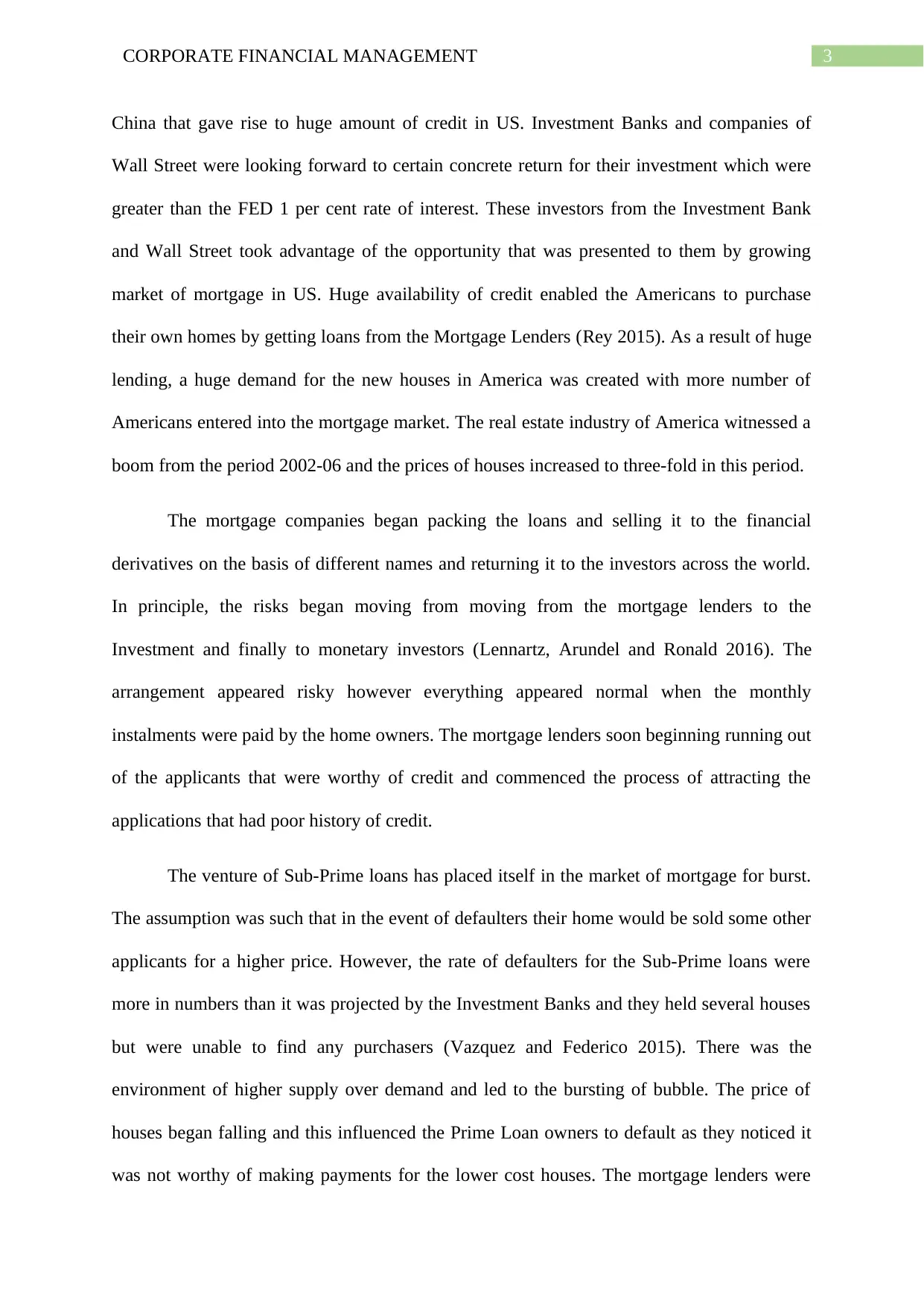
3CORPORATE FINANCIAL MANAGEMENT
China that gave rise to huge amount of credit in US. Investment Banks and companies of
Wall Street were looking forward to certain concrete return for their investment which were
greater than the FED 1 per cent rate of interest. These investors from the Investment Bank
and Wall Street took advantage of the opportunity that was presented to them by growing
market of mortgage in US. Huge availability of credit enabled the Americans to purchase
their own homes by getting loans from the Mortgage Lenders (Rey 2015). As a result of huge
lending, a huge demand for the new houses in America was created with more number of
Americans entered into the mortgage market. The real estate industry of America witnessed a
boom from the period 2002-06 and the prices of houses increased to three-fold in this period.
The mortgage companies began packing the loans and selling it to the financial
derivatives on the basis of different names and returning it to the investors across the world.
In principle, the risks began moving from moving from the mortgage lenders to the
Investment and finally to monetary investors (Lennartz, Arundel and Ronald 2016). The
arrangement appeared risky however everything appeared normal when the monthly
instalments were paid by the home owners. The mortgage lenders soon beginning running out
of the applicants that were worthy of credit and commenced the process of attracting the
applications that had poor history of credit.
The venture of Sub-Prime loans has placed itself in the market of mortgage for burst.
The assumption was such that in the event of defaulters their home would be sold some other
applicants for a higher price. However, the rate of defaulters for the Sub-Prime loans were
more in numbers than it was projected by the Investment Banks and they held several houses
but were unable to find any purchasers (Vazquez and Federico 2015). There was the
environment of higher supply over demand and led to the bursting of bubble. The price of
houses began falling and this influenced the Prime Loan owners to default as they noticed it
was not worthy of making payments for the lower cost houses. The mortgage lenders were
China that gave rise to huge amount of credit in US. Investment Banks and companies of
Wall Street were looking forward to certain concrete return for their investment which were
greater than the FED 1 per cent rate of interest. These investors from the Investment Bank
and Wall Street took advantage of the opportunity that was presented to them by growing
market of mortgage in US. Huge availability of credit enabled the Americans to purchase
their own homes by getting loans from the Mortgage Lenders (Rey 2015). As a result of huge
lending, a huge demand for the new houses in America was created with more number of
Americans entered into the mortgage market. The real estate industry of America witnessed a
boom from the period 2002-06 and the prices of houses increased to three-fold in this period.
The mortgage companies began packing the loans and selling it to the financial
derivatives on the basis of different names and returning it to the investors across the world.
In principle, the risks began moving from moving from the mortgage lenders to the
Investment and finally to monetary investors (Lennartz, Arundel and Ronald 2016). The
arrangement appeared risky however everything appeared normal when the monthly
instalments were paid by the home owners. The mortgage lenders soon beginning running out
of the applicants that were worthy of credit and commenced the process of attracting the
applications that had poor history of credit.
The venture of Sub-Prime loans has placed itself in the market of mortgage for burst.
The assumption was such that in the event of defaulters their home would be sold some other
applicants for a higher price. However, the rate of defaulters for the Sub-Prime loans were
more in numbers than it was projected by the Investment Banks and they held several houses
but were unable to find any purchasers (Vazquez and Federico 2015). There was the
environment of higher supply over demand and led to the bursting of bubble. The price of
houses began falling and this influenced the Prime Loan owners to default as they noticed it
was not worthy of making payments for the lower cost houses. The mortgage lenders were
Secure Best Marks with AI Grader
Need help grading? Try our AI Grader for instant feedback on your assignments.
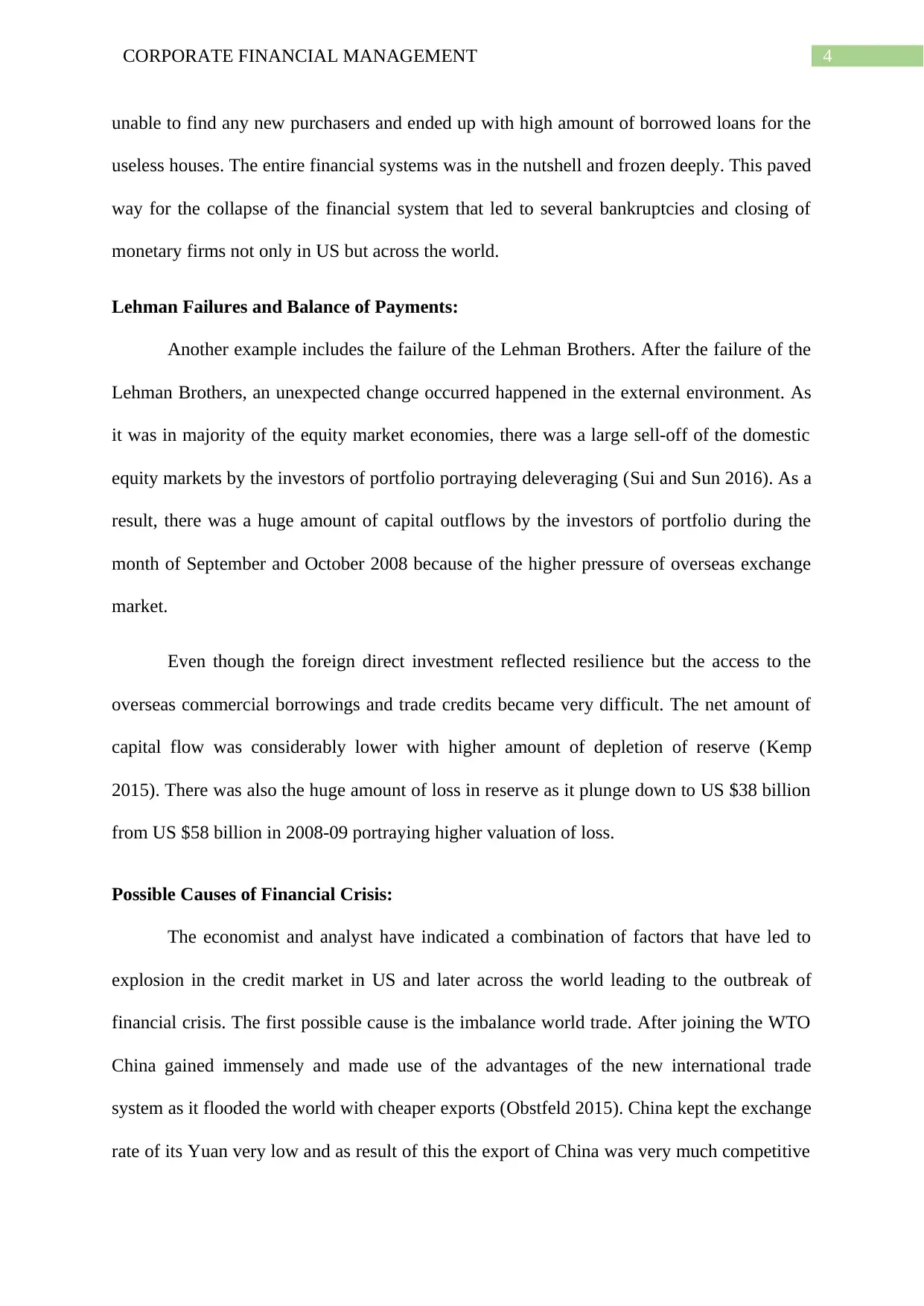
4CORPORATE FINANCIAL MANAGEMENT
unable to find any new purchasers and ended up with high amount of borrowed loans for the
useless houses. The entire financial systems was in the nutshell and frozen deeply. This paved
way for the collapse of the financial system that led to several bankruptcies and closing of
monetary firms not only in US but across the world.
Lehman Failures and Balance of Payments:
Another example includes the failure of the Lehman Brothers. After the failure of the
Lehman Brothers, an unexpected change occurred happened in the external environment. As
it was in majority of the equity market economies, there was a large sell-off of the domestic
equity markets by the investors of portfolio portraying deleveraging (Sui and Sun 2016). As a
result, there was a huge amount of capital outflows by the investors of portfolio during the
month of September and October 2008 because of the higher pressure of overseas exchange
market.
Even though the foreign direct investment reflected resilience but the access to the
overseas commercial borrowings and trade credits became very difficult. The net amount of
capital flow was considerably lower with higher amount of depletion of reserve (Kemp
2015). There was also the huge amount of loss in reserve as it plunge down to US $38 billion
from US $58 billion in 2008-09 portraying higher valuation of loss.
Possible Causes of Financial Crisis:
The economist and analyst have indicated a combination of factors that have led to
explosion in the credit market in US and later across the world leading to the outbreak of
financial crisis. The first possible cause is the imbalance world trade. After joining the WTO
China gained immensely and made use of the advantages of the new international trade
system as it flooded the world with cheaper exports (Obstfeld 2015). China kept the exchange
rate of its Yuan very low and as result of this the export of China was very much competitive
unable to find any new purchasers and ended up with high amount of borrowed loans for the
useless houses. The entire financial systems was in the nutshell and frozen deeply. This paved
way for the collapse of the financial system that led to several bankruptcies and closing of
monetary firms not only in US but across the world.
Lehman Failures and Balance of Payments:
Another example includes the failure of the Lehman Brothers. After the failure of the
Lehman Brothers, an unexpected change occurred happened in the external environment. As
it was in majority of the equity market economies, there was a large sell-off of the domestic
equity markets by the investors of portfolio portraying deleveraging (Sui and Sun 2016). As a
result, there was a huge amount of capital outflows by the investors of portfolio during the
month of September and October 2008 because of the higher pressure of overseas exchange
market.
Even though the foreign direct investment reflected resilience but the access to the
overseas commercial borrowings and trade credits became very difficult. The net amount of
capital flow was considerably lower with higher amount of depletion of reserve (Kemp
2015). There was also the huge amount of loss in reserve as it plunge down to US $38 billion
from US $58 billion in 2008-09 portraying higher valuation of loss.
Possible Causes of Financial Crisis:
The economist and analyst have indicated a combination of factors that have led to
explosion in the credit market in US and later across the world leading to the outbreak of
financial crisis. The first possible cause is the imbalance world trade. After joining the WTO
China gained immensely and made use of the advantages of the new international trade
system as it flooded the world with cheaper exports (Obstfeld 2015). China kept the exchange
rate of its Yuan very low and as result of this the export of China was very much competitive
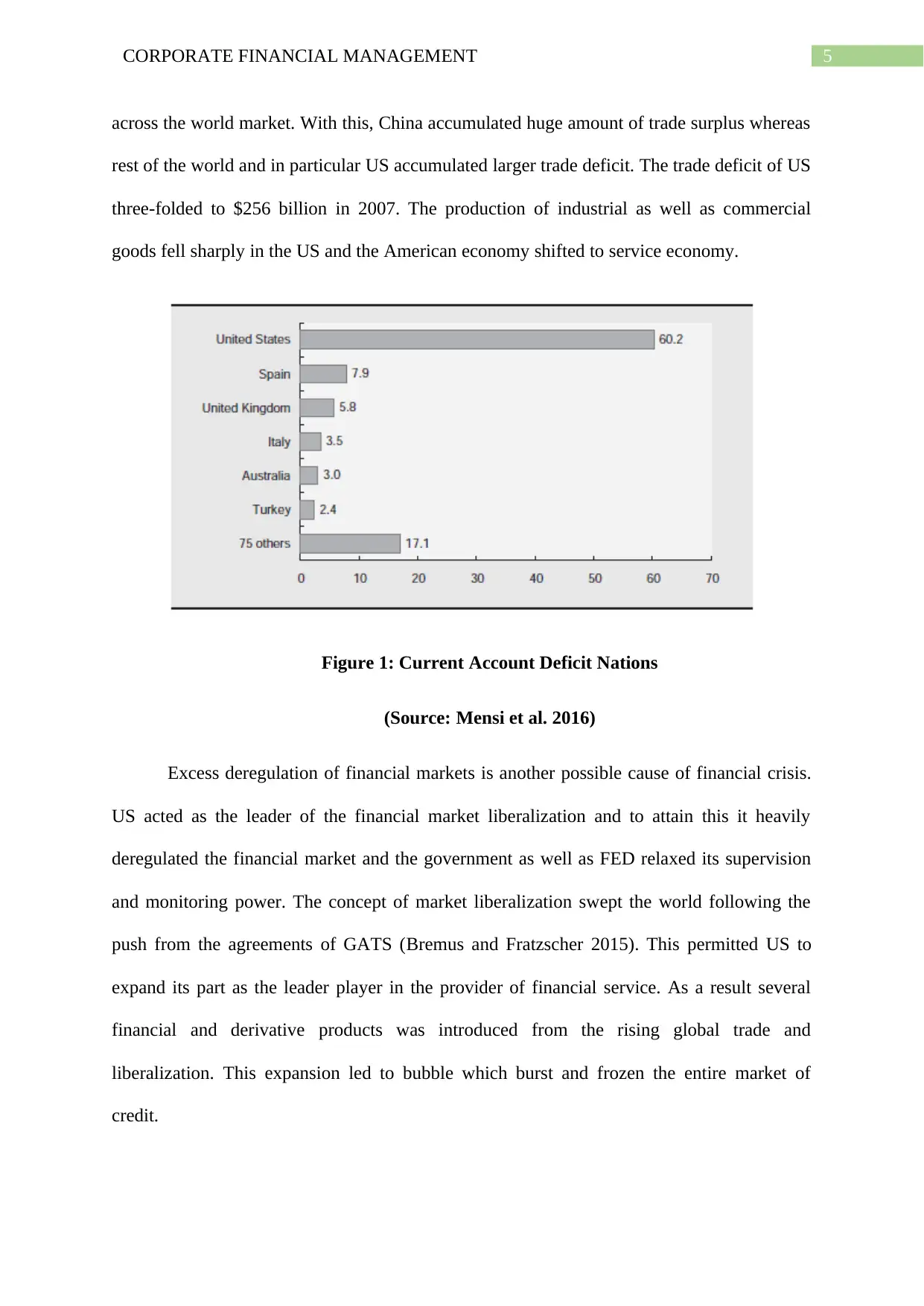
5CORPORATE FINANCIAL MANAGEMENT
across the world market. With this, China accumulated huge amount of trade surplus whereas
rest of the world and in particular US accumulated larger trade deficit. The trade deficit of US
three-folded to $256 billion in 2007. The production of industrial as well as commercial
goods fell sharply in the US and the American economy shifted to service economy.
Figure 1: Current Account Deficit Nations
(Source: Mensi et al. 2016)
Excess deregulation of financial markets is another possible cause of financial crisis.
US acted as the leader of the financial market liberalization and to attain this it heavily
deregulated the financial market and the government as well as FED relaxed its supervision
and monitoring power. The concept of market liberalization swept the world following the
push from the agreements of GATS (Bremus and Fratzscher 2015). This permitted US to
expand its part as the leader player in the provider of financial service. As a result several
financial and derivative products was introduced from the rising global trade and
liberalization. This expansion led to bubble which burst and frozen the entire market of
credit.
across the world market. With this, China accumulated huge amount of trade surplus whereas
rest of the world and in particular US accumulated larger trade deficit. The trade deficit of US
three-folded to $256 billion in 2007. The production of industrial as well as commercial
goods fell sharply in the US and the American economy shifted to service economy.
Figure 1: Current Account Deficit Nations
(Source: Mensi et al. 2016)
Excess deregulation of financial markets is another possible cause of financial crisis.
US acted as the leader of the financial market liberalization and to attain this it heavily
deregulated the financial market and the government as well as FED relaxed its supervision
and monitoring power. The concept of market liberalization swept the world following the
push from the agreements of GATS (Bremus and Fratzscher 2015). This permitted US to
expand its part as the leader player in the provider of financial service. As a result several
financial and derivative products was introduced from the rising global trade and
liberalization. This expansion led to bubble which burst and frozen the entire market of
credit.
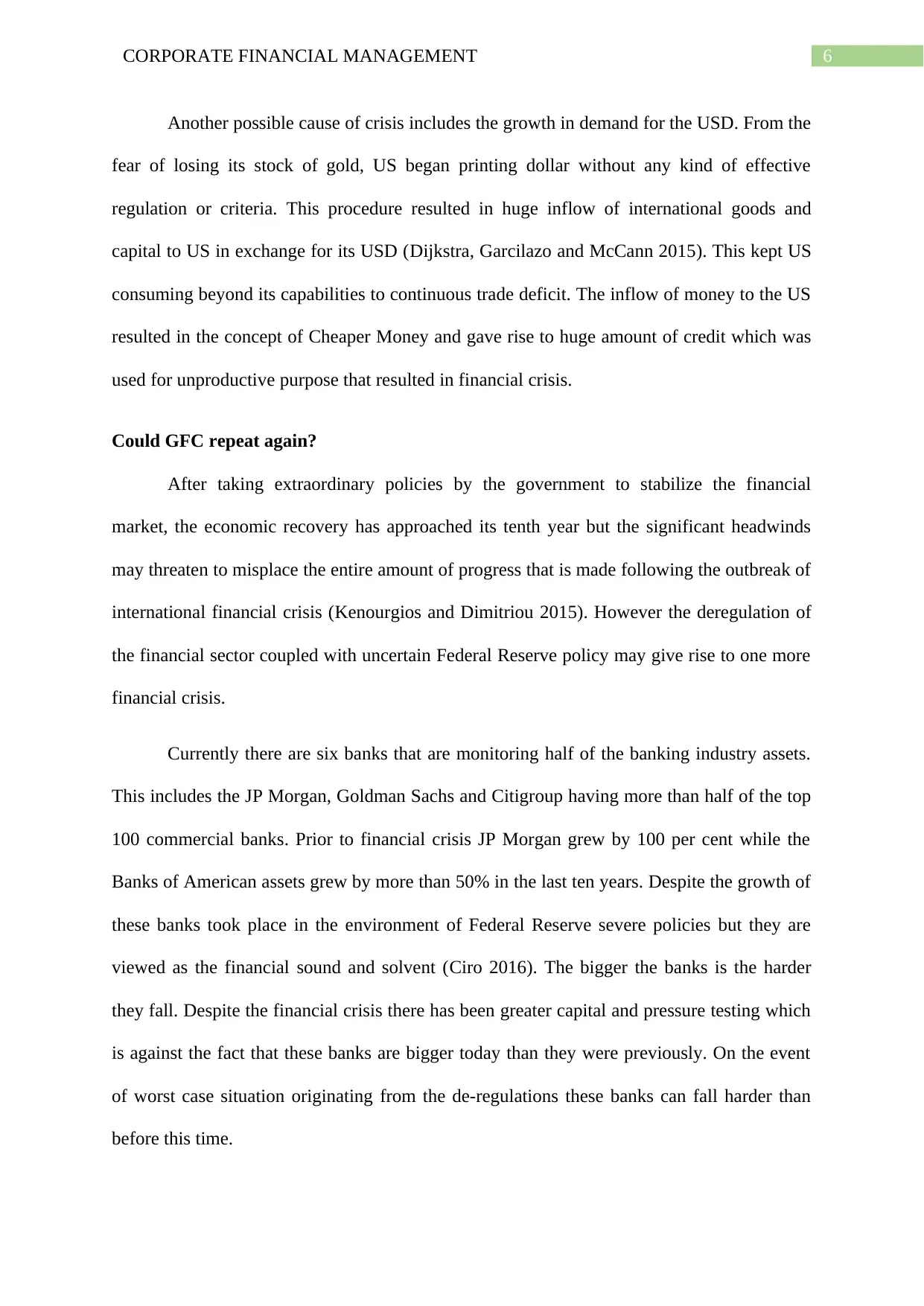
6CORPORATE FINANCIAL MANAGEMENT
Another possible cause of crisis includes the growth in demand for the USD. From the
fear of losing its stock of gold, US began printing dollar without any kind of effective
regulation or criteria. This procedure resulted in huge inflow of international goods and
capital to US in exchange for its USD (Dijkstra, Garcilazo and McCann 2015). This kept US
consuming beyond its capabilities to continuous trade deficit. The inflow of money to the US
resulted in the concept of Cheaper Money and gave rise to huge amount of credit which was
used for unproductive purpose that resulted in financial crisis.
Could GFC repeat again?
After taking extraordinary policies by the government to stabilize the financial
market, the economic recovery has approached its tenth year but the significant headwinds
may threaten to misplace the entire amount of progress that is made following the outbreak of
international financial crisis (Kenourgios and Dimitriou 2015). However the deregulation of
the financial sector coupled with uncertain Federal Reserve policy may give rise to one more
financial crisis.
Currently there are six banks that are monitoring half of the banking industry assets.
This includes the JP Morgan, Goldman Sachs and Citigroup having more than half of the top
100 commercial banks. Prior to financial crisis JP Morgan grew by 100 per cent while the
Banks of American assets grew by more than 50% in the last ten years. Despite the growth of
these banks took place in the environment of Federal Reserve severe policies but they are
viewed as the financial sound and solvent (Ciro 2016). The bigger the banks is the harder
they fall. Despite the financial crisis there has been greater capital and pressure testing which
is against the fact that these banks are bigger today than they were previously. On the event
of worst case situation originating from the de-regulations these banks can fall harder than
before this time.
Another possible cause of crisis includes the growth in demand for the USD. From the
fear of losing its stock of gold, US began printing dollar without any kind of effective
regulation or criteria. This procedure resulted in huge inflow of international goods and
capital to US in exchange for its USD (Dijkstra, Garcilazo and McCann 2015). This kept US
consuming beyond its capabilities to continuous trade deficit. The inflow of money to the US
resulted in the concept of Cheaper Money and gave rise to huge amount of credit which was
used for unproductive purpose that resulted in financial crisis.
Could GFC repeat again?
After taking extraordinary policies by the government to stabilize the financial
market, the economic recovery has approached its tenth year but the significant headwinds
may threaten to misplace the entire amount of progress that is made following the outbreak of
international financial crisis (Kenourgios and Dimitriou 2015). However the deregulation of
the financial sector coupled with uncertain Federal Reserve policy may give rise to one more
financial crisis.
Currently there are six banks that are monitoring half of the banking industry assets.
This includes the JP Morgan, Goldman Sachs and Citigroup having more than half of the top
100 commercial banks. Prior to financial crisis JP Morgan grew by 100 per cent while the
Banks of American assets grew by more than 50% in the last ten years. Despite the growth of
these banks took place in the environment of Federal Reserve severe policies but they are
viewed as the financial sound and solvent (Ciro 2016). The bigger the banks is the harder
they fall. Despite the financial crisis there has been greater capital and pressure testing which
is against the fact that these banks are bigger today than they were previously. On the event
of worst case situation originating from the de-regulations these banks can fall harder than
before this time.
Paraphrase This Document
Need a fresh take? Get an instant paraphrase of this document with our AI Paraphraser
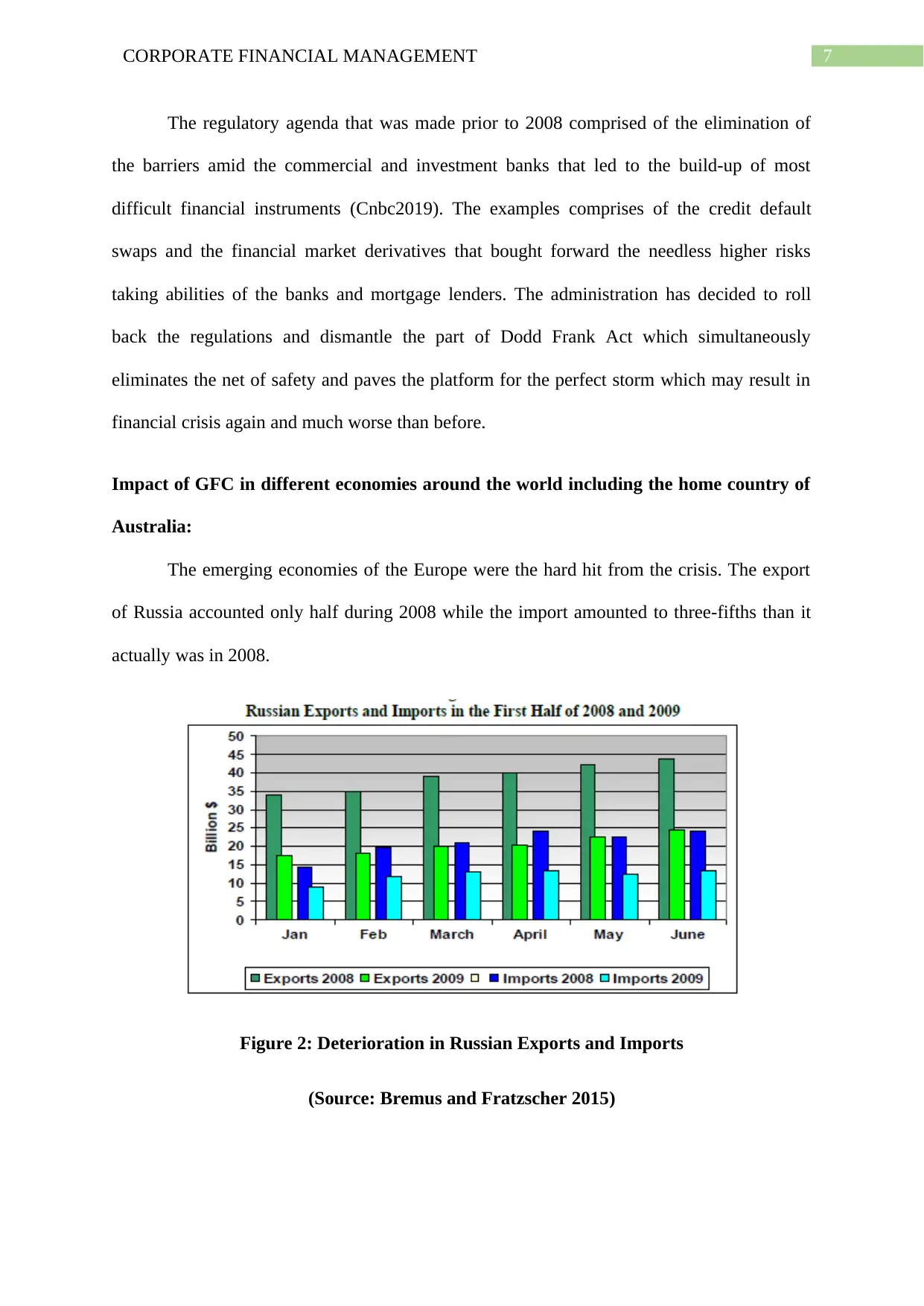
7CORPORATE FINANCIAL MANAGEMENT
The regulatory agenda that was made prior to 2008 comprised of the elimination of
the barriers amid the commercial and investment banks that led to the build-up of most
difficult financial instruments (Cnbc2019). The examples comprises of the credit default
swaps and the financial market derivatives that bought forward the needless higher risks
taking abilities of the banks and mortgage lenders. The administration has decided to roll
back the regulations and dismantle the part of Dodd Frank Act which simultaneously
eliminates the net of safety and paves the platform for the perfect storm which may result in
financial crisis again and much worse than before.
Impact of GFC in different economies around the world including the home country of
Australia:
The emerging economies of the Europe were the hard hit from the crisis. The export
of Russia accounted only half during 2008 while the import amounted to three-fifths than it
actually was in 2008.
Figure 2: Deterioration in Russian Exports and Imports
(Source: Bremus and Fratzscher 2015)
The regulatory agenda that was made prior to 2008 comprised of the elimination of
the barriers amid the commercial and investment banks that led to the build-up of most
difficult financial instruments (Cnbc2019). The examples comprises of the credit default
swaps and the financial market derivatives that bought forward the needless higher risks
taking abilities of the banks and mortgage lenders. The administration has decided to roll
back the regulations and dismantle the part of Dodd Frank Act which simultaneously
eliminates the net of safety and paves the platform for the perfect storm which may result in
financial crisis again and much worse than before.
Impact of GFC in different economies around the world including the home country of
Australia:
The emerging economies of the Europe were the hard hit from the crisis. The export
of Russia accounted only half during 2008 while the import amounted to three-fifths than it
actually was in 2008.
Figure 2: Deterioration in Russian Exports and Imports
(Source: Bremus and Fratzscher 2015)
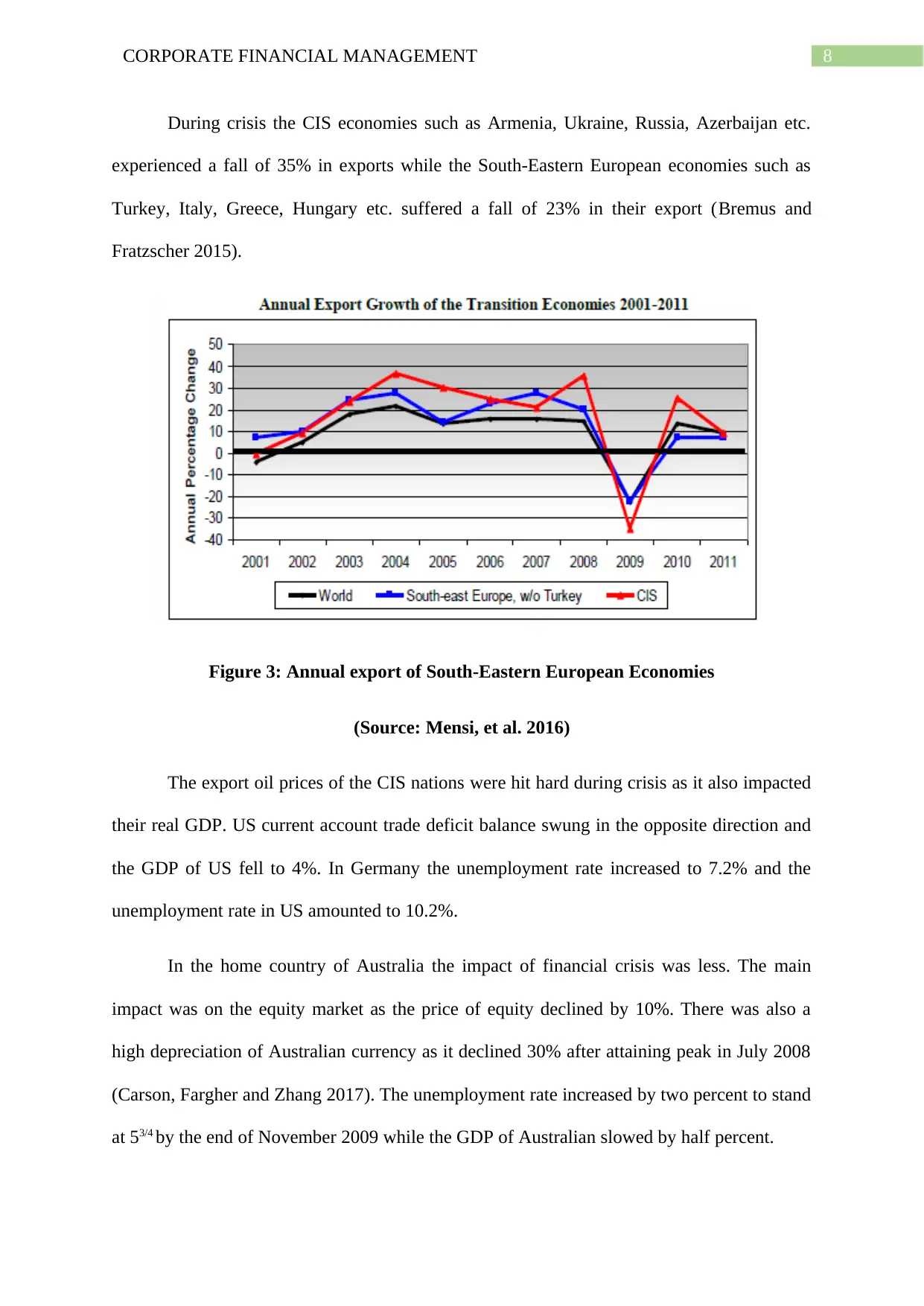
8CORPORATE FINANCIAL MANAGEMENT
During crisis the CIS economies such as Armenia, Ukraine, Russia, Azerbaijan etc.
experienced a fall of 35% in exports while the South-Eastern European economies such as
Turkey, Italy, Greece, Hungary etc. suffered a fall of 23% in their export (Bremus and
Fratzscher 2015).
Figure 3: Annual export of South-Eastern European Economies
(Source: Mensi, et al. 2016)
The export oil prices of the CIS nations were hit hard during crisis as it also impacted
their real GDP. US current account trade deficit balance swung in the opposite direction and
the GDP of US fell to 4%. In Germany the unemployment rate increased to 7.2% and the
unemployment rate in US amounted to 10.2%.
In the home country of Australia the impact of financial crisis was less. The main
impact was on the equity market as the price of equity declined by 10%. There was also a
high depreciation of Australian currency as it declined 30% after attaining peak in July 2008
(Carson, Fargher and Zhang 2017). The unemployment rate increased by two percent to stand
at 53/4 by the end of November 2009 while the GDP of Australian slowed by half percent.
During crisis the CIS economies such as Armenia, Ukraine, Russia, Azerbaijan etc.
experienced a fall of 35% in exports while the South-Eastern European economies such as
Turkey, Italy, Greece, Hungary etc. suffered a fall of 23% in their export (Bremus and
Fratzscher 2015).
Figure 3: Annual export of South-Eastern European Economies
(Source: Mensi, et al. 2016)
The export oil prices of the CIS nations were hit hard during crisis as it also impacted
their real GDP. US current account trade deficit balance swung in the opposite direction and
the GDP of US fell to 4%. In Germany the unemployment rate increased to 7.2% and the
unemployment rate in US amounted to 10.2%.
In the home country of Australia the impact of financial crisis was less. The main
impact was on the equity market as the price of equity declined by 10%. There was also a
high depreciation of Australian currency as it declined 30% after attaining peak in July 2008
(Carson, Fargher and Zhang 2017). The unemployment rate increased by two percent to stand
at 53/4 by the end of November 2009 while the GDP of Australian slowed by half percent.
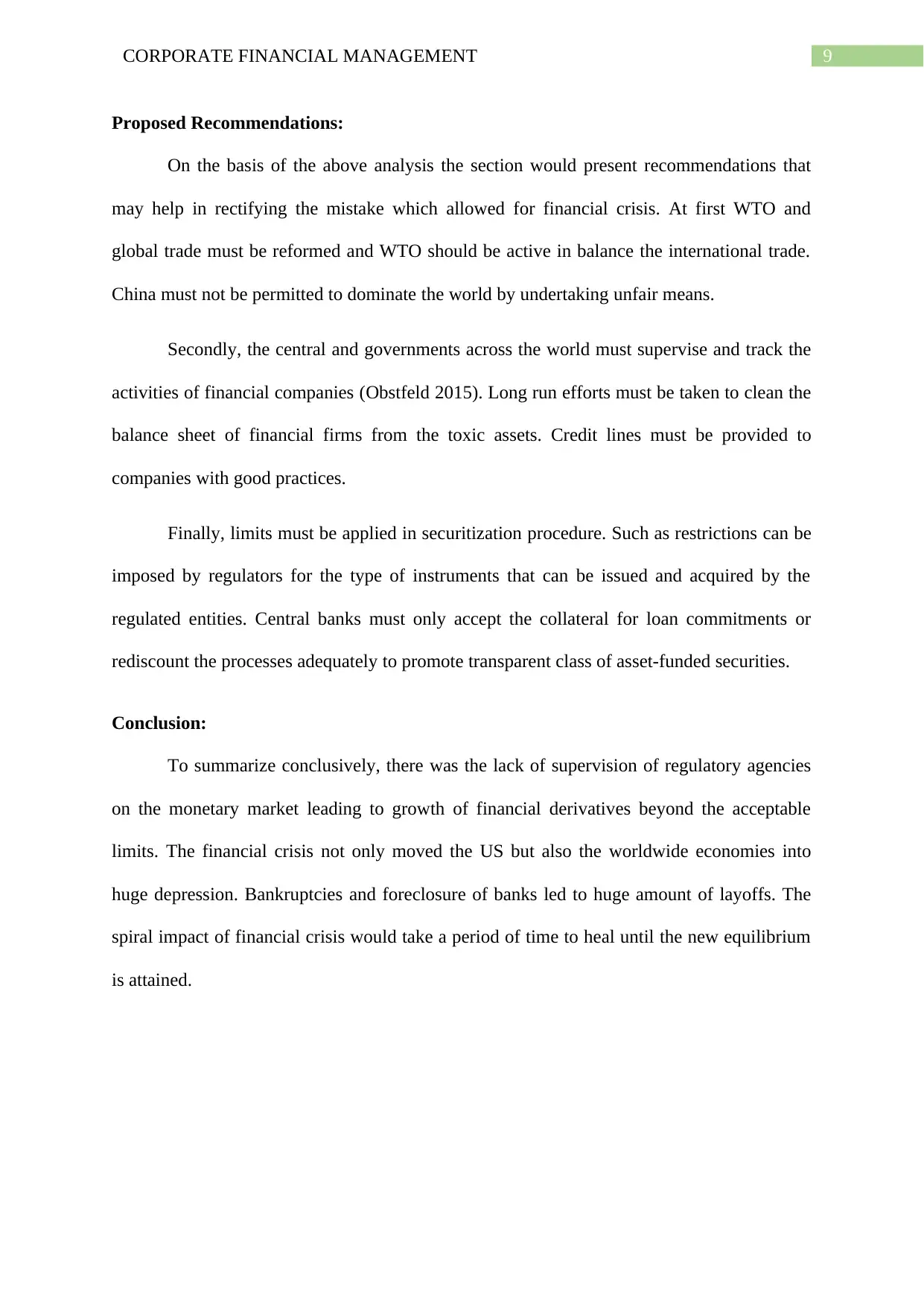
9CORPORATE FINANCIAL MANAGEMENT
Proposed Recommendations:
On the basis of the above analysis the section would present recommendations that
may help in rectifying the mistake which allowed for financial crisis. At first WTO and
global trade must be reformed and WTO should be active in balance the international trade.
China must not be permitted to dominate the world by undertaking unfair means.
Secondly, the central and governments across the world must supervise and track the
activities of financial companies (Obstfeld 2015). Long run efforts must be taken to clean the
balance sheet of financial firms from the toxic assets. Credit lines must be provided to
companies with good practices.
Finally, limits must be applied in securitization procedure. Such as restrictions can be
imposed by regulators for the type of instruments that can be issued and acquired by the
regulated entities. Central banks must only accept the collateral for loan commitments or
rediscount the processes adequately to promote transparent class of asset-funded securities.
Conclusion:
To summarize conclusively, there was the lack of supervision of regulatory agencies
on the monetary market leading to growth of financial derivatives beyond the acceptable
limits. The financial crisis not only moved the US but also the worldwide economies into
huge depression. Bankruptcies and foreclosure of banks led to huge amount of layoffs. The
spiral impact of financial crisis would take a period of time to heal until the new equilibrium
is attained.
Proposed Recommendations:
On the basis of the above analysis the section would present recommendations that
may help in rectifying the mistake which allowed for financial crisis. At first WTO and
global trade must be reformed and WTO should be active in balance the international trade.
China must not be permitted to dominate the world by undertaking unfair means.
Secondly, the central and governments across the world must supervise and track the
activities of financial companies (Obstfeld 2015). Long run efforts must be taken to clean the
balance sheet of financial firms from the toxic assets. Credit lines must be provided to
companies with good practices.
Finally, limits must be applied in securitization procedure. Such as restrictions can be
imposed by regulators for the type of instruments that can be issued and acquired by the
regulated entities. Central banks must only accept the collateral for loan commitments or
rediscount the processes adequately to promote transparent class of asset-funded securities.
Conclusion:
To summarize conclusively, there was the lack of supervision of regulatory agencies
on the monetary market leading to growth of financial derivatives beyond the acceptable
limits. The financial crisis not only moved the US but also the worldwide economies into
huge depression. Bankruptcies and foreclosure of banks led to huge amount of layoffs. The
spiral impact of financial crisis would take a period of time to heal until the new equilibrium
is attained.
Secure Best Marks with AI Grader
Need help grading? Try our AI Grader for instant feedback on your assignments.
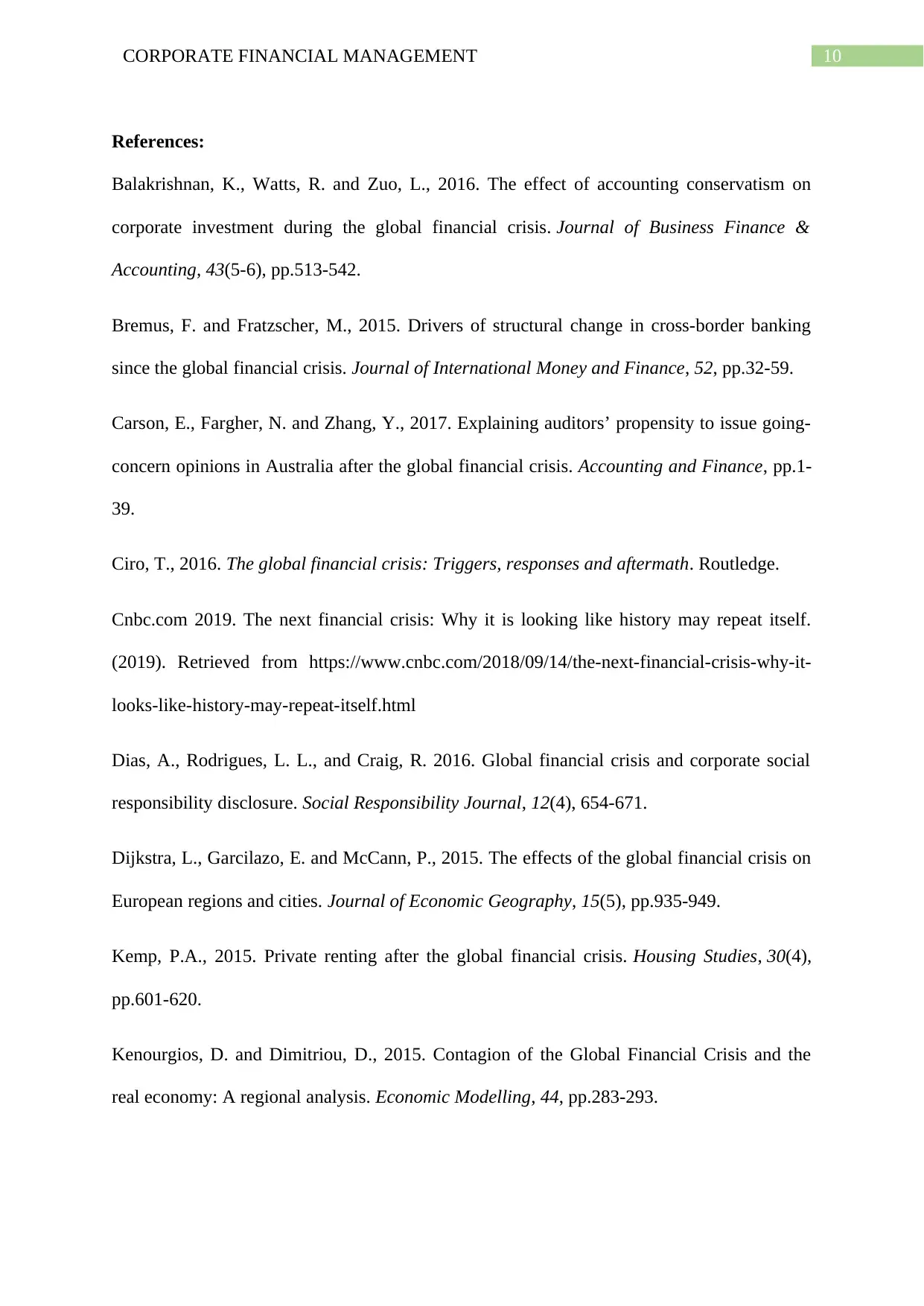
10CORPORATE FINANCIAL MANAGEMENT
References:
Balakrishnan, K., Watts, R. and Zuo, L., 2016. The effect of accounting conservatism on
corporate investment during the global financial crisis. Journal of Business Finance &
Accounting, 43(5-6), pp.513-542.
Bremus, F. and Fratzscher, M., 2015. Drivers of structural change in cross-border banking
since the global financial crisis. Journal of International Money and Finance, 52, pp.32-59.
Carson, E., Fargher, N. and Zhang, Y., 2017. Explaining auditors’ propensity to issue going-
concern opinions in Australia after the global financial crisis. Accounting and Finance, pp.1-
39.
Ciro, T., 2016. The global financial crisis: Triggers, responses and aftermath. Routledge.
Cnbc.com 2019. The next financial crisis: Why it is looking like history may repeat itself.
(2019). Retrieved from https://www.cnbc.com/2018/09/14/the-next-financial-crisis-why-it-
looks-like-history-may-repeat-itself.html
Dias, A., Rodrigues, L. L., and Craig, R. 2016. Global financial crisis and corporate social
responsibility disclosure. Social Responsibility Journal, 12(4), 654-671.
Dijkstra, L., Garcilazo, E. and McCann, P., 2015. The effects of the global financial crisis on
European regions and cities. Journal of Economic Geography, 15(5), pp.935-949.
Kemp, P.A., 2015. Private renting after the global financial crisis. Housing Studies, 30(4),
pp.601-620.
Kenourgios, D. and Dimitriou, D., 2015. Contagion of the Global Financial Crisis and the
real economy: A regional analysis. Economic Modelling, 44, pp.283-293.
References:
Balakrishnan, K., Watts, R. and Zuo, L., 2016. The effect of accounting conservatism on
corporate investment during the global financial crisis. Journal of Business Finance &
Accounting, 43(5-6), pp.513-542.
Bremus, F. and Fratzscher, M., 2015. Drivers of structural change in cross-border banking
since the global financial crisis. Journal of International Money and Finance, 52, pp.32-59.
Carson, E., Fargher, N. and Zhang, Y., 2017. Explaining auditors’ propensity to issue going-
concern opinions in Australia after the global financial crisis. Accounting and Finance, pp.1-
39.
Ciro, T., 2016. The global financial crisis: Triggers, responses and aftermath. Routledge.
Cnbc.com 2019. The next financial crisis: Why it is looking like history may repeat itself.
(2019). Retrieved from https://www.cnbc.com/2018/09/14/the-next-financial-crisis-why-it-
looks-like-history-may-repeat-itself.html
Dias, A., Rodrigues, L. L., and Craig, R. 2016. Global financial crisis and corporate social
responsibility disclosure. Social Responsibility Journal, 12(4), 654-671.
Dijkstra, L., Garcilazo, E. and McCann, P., 2015. The effects of the global financial crisis on
European regions and cities. Journal of Economic Geography, 15(5), pp.935-949.
Kemp, P.A., 2015. Private renting after the global financial crisis. Housing Studies, 30(4),
pp.601-620.
Kenourgios, D. and Dimitriou, D., 2015. Contagion of the Global Financial Crisis and the
real economy: A regional analysis. Economic Modelling, 44, pp.283-293.
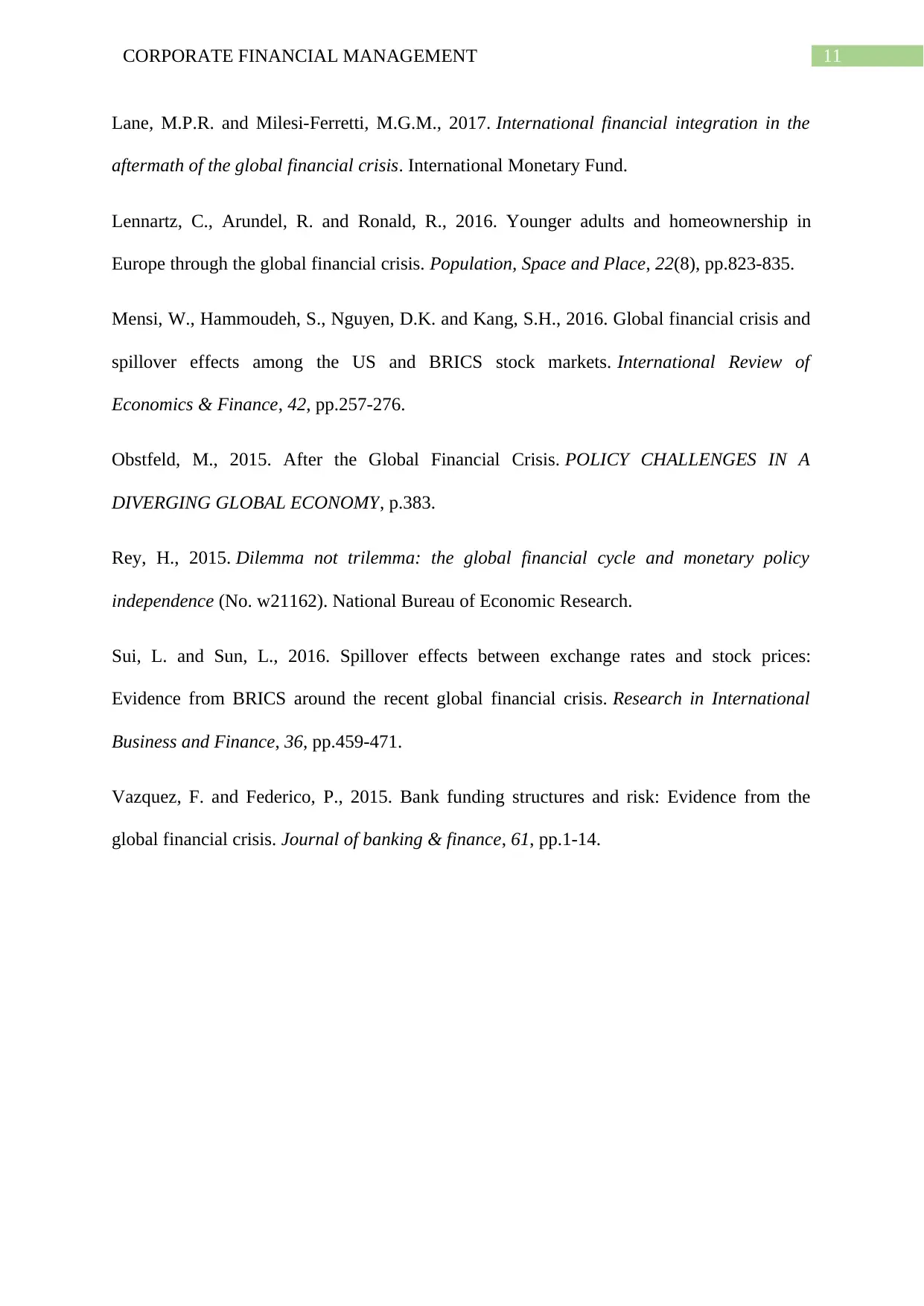
11CORPORATE FINANCIAL MANAGEMENT
Lane, M.P.R. and Milesi-Ferretti, M.G.M., 2017. International financial integration in the
aftermath of the global financial crisis. International Monetary Fund.
Lennartz, C., Arundel, R. and Ronald, R., 2016. Younger adults and homeownership in
Europe through the global financial crisis. Population, Space and Place, 22(8), pp.823-835.
Mensi, W., Hammoudeh, S., Nguyen, D.K. and Kang, S.H., 2016. Global financial crisis and
spillover effects among the US and BRICS stock markets. International Review of
Economics & Finance, 42, pp.257-276.
Obstfeld, M., 2015. After the Global Financial Crisis. POLICY CHALLENGES IN A
DIVERGING GLOBAL ECONOMY, p.383.
Rey, H., 2015. Dilemma not trilemma: the global financial cycle and monetary policy
independence (No. w21162). National Bureau of Economic Research.
Sui, L. and Sun, L., 2016. Spillover effects between exchange rates and stock prices:
Evidence from BRICS around the recent global financial crisis. Research in International
Business and Finance, 36, pp.459-471.
Vazquez, F. and Federico, P., 2015. Bank funding structures and risk: Evidence from the
global financial crisis. Journal of banking & finance, 61, pp.1-14.
Lane, M.P.R. and Milesi-Ferretti, M.G.M., 2017. International financial integration in the
aftermath of the global financial crisis. International Monetary Fund.
Lennartz, C., Arundel, R. and Ronald, R., 2016. Younger adults and homeownership in
Europe through the global financial crisis. Population, Space and Place, 22(8), pp.823-835.
Mensi, W., Hammoudeh, S., Nguyen, D.K. and Kang, S.H., 2016. Global financial crisis and
spillover effects among the US and BRICS stock markets. International Review of
Economics & Finance, 42, pp.257-276.
Obstfeld, M., 2015. After the Global Financial Crisis. POLICY CHALLENGES IN A
DIVERGING GLOBAL ECONOMY, p.383.
Rey, H., 2015. Dilemma not trilemma: the global financial cycle and monetary policy
independence (No. w21162). National Bureau of Economic Research.
Sui, L. and Sun, L., 2016. Spillover effects between exchange rates and stock prices:
Evidence from BRICS around the recent global financial crisis. Research in International
Business and Finance, 36, pp.459-471.
Vazquez, F. and Federico, P., 2015. Bank funding structures and risk: Evidence from the
global financial crisis. Journal of banking & finance, 61, pp.1-14.
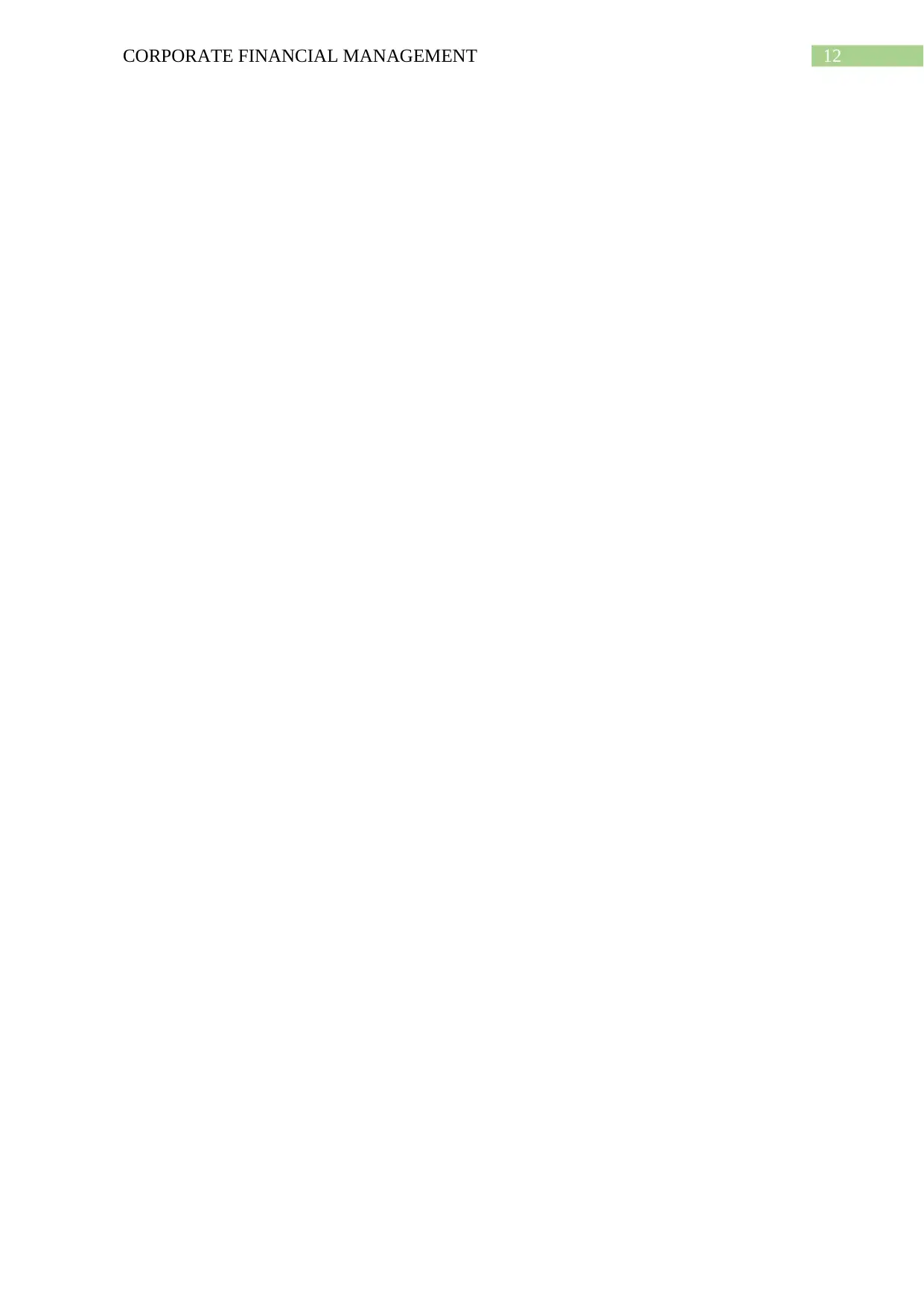
12CORPORATE FINANCIAL MANAGEMENT
1 out of 13
Related Documents
Your All-in-One AI-Powered Toolkit for Academic Success.
+13062052269
info@desklib.com
Available 24*7 on WhatsApp / Email
![[object Object]](/_next/static/media/star-bottom.7253800d.svg)
Unlock your academic potential
© 2024 | Zucol Services PVT LTD | All rights reserved.





